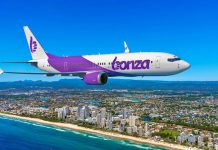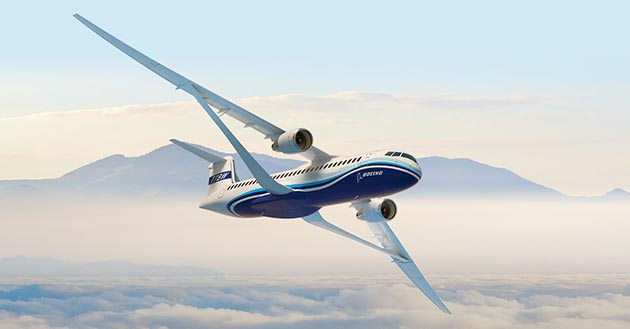Boeing has unveiled a new truss-braced folding wing design it says will fly faster and higher than previous concepts.
The US manufacturer says its new version of the Transonic Truss-based Wing will offer unprecedented aerodynamic efficiency while flying at Mach 0.8.
It has been developed through a collaboration with NASA as part of the Subsonic Ultra Green Aircraft Research (SUGAR) program.
The two organizations have been studying the concept for almost a decade in an attempt to adapt the long, thin wings seen on gliders to commercial aircraft.
The latest design would see ultra-thin folding wings measuring 170ft from end to end made possible by the presence of an optimized truss supporting the extended length.
“Originally, the TTBW was designed to fly at speeds of Mach 0.70 – 0.75,’’ Boeing said on its website.
“To increase the aircraft’s cruise speed, the new concept now has an optimized truss and a modified wing sweep.
“By adjusting the wing sweep angle, the truss can carry lift more efficiently. The end result was a more integrated design that significantly improved vehicle performance.”
The new design came after extensive wind tunnel testing at NASA Ames Research Center.
The aviation industry is searching for ways to meet ambitious environmental goals to become carbon neutral by 2020 and then halve greenhouse emissions relative to 2005 levels by 2050.
Initiatives include a move to introduce the world’s first global design certification aimed at lowering greenhouse gas emissions and a carbon offset scheme.
New aircraft designs introduced from 2020 will be subject to the world’s first global design standard.
The design standard will apply to new aircraft from 2020 and also to deliveries of aircraft already in production from 2023.
READ plane makers face new environmental standards.
Manufacturers of in-production aircraft failing to meet the standard by 2028 will be forced to cease manufacturing the planes unless their designs are modified.
The decision to adopt a global carbon offset scheme, the Carbon Offsetting and Reduction Scheme for International Aviation (CORSIA), was also a world-first.
It will start as a voluntary scheme from 2021 to 2026 but will then become mandatory across the aviation industry.
























